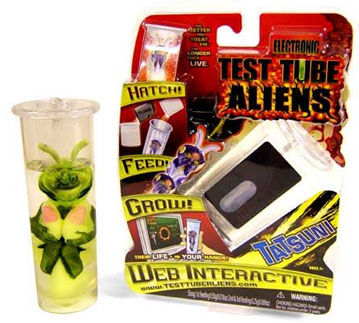Test Tube Aliens from 4Kidz
Jul 28th, 2007 by Gary

We find these pets extremely interesting. Although somewhat basic, they reopen an old category (Sea Monkeys) and open a new one (direct Internet to virtual pet interaction via flashing lights) that may provide many opportunities for future virtual pet designers.
The brief instructions below come from their online instruction manual. You can also watch a YouTube video from 4Kidz on how to start one up.
Caring For a Test Tube Alien:
You get a clear cylinder with the alien contained inside a white blob they call a cocoon with a tranpsort stick in the top of it. Take the lid (feeding hatch) off the test tube. Remove and discard the transport stick. With the alien cocoon in it, hold your test tube over the sink and fill it full of water. The cocoon will dissolve, fizz and run over. Keep adding water till the fizzing stops.
When the alien emerges from the cocoon its heart will begin to flash (an led). It is now alive. Drain the test tube and wash it out several times. It is very important to remove all of the hatching residue.
Get a cup of glass and mix some of the prepackaged food that came for your alien. It is called Sloog. Use the package marked “1st Feeding”. Mix it with about 150ml of water, then very slowly pour it into the test tube till it comes about half way up the alien’s antennae and put the lid (feeding hatch) back on.
Too little food (water level too low) and you alien is starving and his heart starts flashing orange, just right and his heart flashed red, too much he starts to drow and his heart flashes green.
Feed you alien Sloog for the next 14 days and he will grow into an adult. Once full grown, he can live on tap water.
He also needs exactly 12 hours of light and 12 hours of darkness. If given too much light he will panic and his heart will race. Too much dark and his heart slows down.
Now for the cool part. Your alien can respond directly to the Internet at www.testtubealiens.com. First you have to register your pet online, then hold them up to the screen in a darkened room and the computer will send a series of flashes to the controller in the pet to interrogate it. The pet will respond with a series of lights you record on the site. The web site will then tell you the aliens age and how many times it has been left too long in the light or dark. You can even place it in suspended animation (coma mode), or “provoke” it.
Wikipedia on How Test Tube Aliens Works:
The white blob (cocoon) you start with contains a polymer called Polyacrylamide. The polymer soaks up water and expands up to 8 times its original size. The “Sloog” you feed you alien is actually slowing their growth. “Sloog” contains a week acid that slows the expansion of the polymer so it occurs over several days instead of almost all at once.
The alien senses the acid through electrodes on the end of its antennae. They also detect water level.
The website interacts with a light detector in the aliens head. The alien then responds to the flashes.
Good Aliens and Bad Aliens
At the moment there are six different aliens. Three are good and three are bad. They don’t really act good or bad. You only determine that by their name. When you buy one it comes with its name on the box.
Kurion – Good
Yagoni – Good
Tatsuni – Good
Namako – Evil
Takon – Evil
Shako – Evil
The storyline is they come from a dying planet called Naratuko. Your test tube simulates that environment until they can find a new planet to colonize.
Their website, Test Tube Aliens, is well done, colorful and interesting. It also has three online games, one of which resembles Space Invaders (drops good and bad aliens in test tubes and you launch missiles at the ones not on your side).
We find the Test Tube Alien concept pretty interesting, but have a little concern about young children and the “Sloog” as well as with them directly handling the aliens.
In the late 1950’s Sea Monkeys (a kind of brine shrimp) were first sold as a kit called “Instant Life” by Harold von Braunhut. You added some packets to water for a few days and a real, live Sea Monkey colony began to grow and could be raised with minimal care. They were not a virtual pet, but pretty close to it.
Back in 2004, Mattel licensed Video Encoded Invisible Light (VEIL) from VEIL Interactive and used it in some Batman toys that responded to the TV show. The early toys were a bit expensive, but VEIL technology would also seemingly allow the TV or Internet to directly communicate with a virtual pet.
4Kidz does a nice job of just using some flashes as all they need is a low bandwidth signal to request output from the pet. You then key that output (identify which lights it turns on) into the computer and it reads the output for you.
This same flashing technique could be used with more traditional plush, robotic, or keychain virtual pets and is in no way limited to the wet test tube pets in this example. Yes, you could just flip some switch on the pet to request the readout, but its much cooler when the web site requests it directly.


